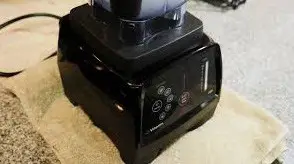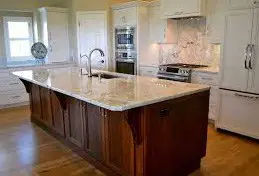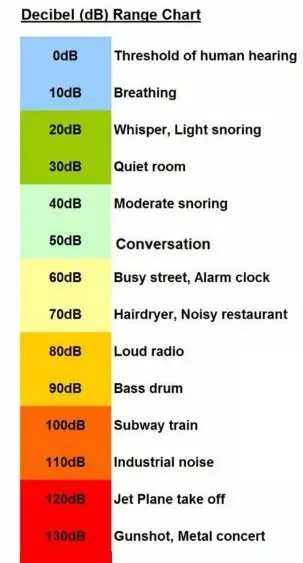Is it possible to completely quiet a blender? The answer is not likely. I do have 8great tricks on how to soundproof a blender to make it as quiet as possible.
There are many reasons why you would want to quiet a blender. For me, it’s early morning smoothies before a workout, a sleeping newborn, and because I just hate the noise of a loud blender.
I use a blender probably twice a day. It seems that both of these times that I use my blender happen to be the worst times ever.
It’s either very early in the morning or at a time when my newborn just fell asleep after fussing for an hour or two.
I decided to do a little searching to see what I could find about quieting a blender. Here are 8 things you can do to help minimize the noise of a blender.
1. Place a Thick Towel Underneath Your Blender

The first trick is to start using a towel while you are blending. Take a thick towel and give it a fold or two.
Place it directly underneath your blender like a small platform. The fancy word for this is decoupling.
This simply means you are dampening the noise and vibration of your blender by placing it on the towel.
Make sure the towel is thick enough before you place the blender on top. Having a thin layer of towel underneath your blender will almost be as effective as not having it at all.
The reason this reduces noise is that most people use blenders on their kitchen countertops. Many countertops are made of hard materials like granite or wood.
Blending on a hard surface like this will cause an extreme amount of noise from the vibration caused by the blender on top of the already noisy motor.
This is a great method to use because it is most likely free. I haven’t met anyone that didn’t have a kitchen towel lying around somewhere. The next time you plan on using your blender, go ahead and give this a try.
2. Relocate Your Blender

Where you are using your blender has a pretty big impact on how loud it will be once you turn it on.
A blender generates multiple high-frequency sounds, which can easily bounce off walls to make the noise even louder.
I’m not telling you to go outside when you want to make a smoothie, but do make sure that your blender is not close to a wall or any other enclosures that can cause an echo.
The best thing to do is move your blender to a spot in your kitchen where it is the farthest away from walls or other appliances that may cause an echo when you turn it on.
Some big kitchens have an island or countertop in the middle. This is the best place, hands down, to use your blender.
3. Soundproof the Nearby Surrounding Wall
If you are not lucky enough to have a kitchen island like me, then you can try soundproofing the surrounding wall nearest your blender.
Be sure to make this spot your designated blender area. You can then consider placing soundproof foam on the walls surrounding your blender.
Soundproof foam will help to absorb the noise and reduce echo from your loud blender. The only thing you will need to do is cut the foam to the size of your liking and stick them on the walls.
To stick the soundproof foam on the walls, you can simply use double-sided tape.
This happens to work great if you don’t have any other spots to run your blender, and you must use it near a corner.
Simply place a small square of soundproof foam in front of your blender and then on whichever side the wall is as well. This will help lessen the amount of echo bounced off of the walls nearest to it.
4. Make a Sound Enclosure Box for Your Blender
Have you ever been to a smoothie shop? Have you noticed how commercial blenders have a build in sound enclosure box?
That’s because it works. The next time you go to your favorite juice spot, take a look at how loud their blenders are before and after they close the lid to the enclosure.
It is literally a night and day difference. Nobody wants to hear 5 blenders simultaneously going off at once. That is a recipe for an ear bleed.
Not everybody can afford a 1,000$ commercial grade blender. So a cheaper alternative to buying a commercial blender or a blender with an enclosure is to make an enclosure yourself.
I came across this article that teaches you how to create a soundproof enclosure for any object.
You can simply purchase some Soundboard from your local hardware store and line it with a type of thick mat to help dampen the noise from the inside.
Of course, when you create this box, you will need to leave one side open to use the buttons or create a front piece that you can easily remove.
5. Purchase Your Own Sound Enclosure
This is the alternative to making your own sound enclosure. This will vary a bit depending on the brand of your blender. Not all manufacturers have this added accessory.
As a matter of fact, many blenders do not have this as a secondary option. You most likely have to buy a blender that already has this implemented, but if you happen to have a blender that does have these for purchase, then you are in luck.
If you have a Vita-Mix touch-and-go blender, then you can purchase their blender cover from amazon.
Just make sure you have the correct model to use it on.
Do a simple search to check and see if there are any covers or sound enclosures supported for your blender.
6. Use a Rubber Mat Under Your Blender

A perfect alternative to using a kitchen towel is to purchase a rubber bar mat like this one from amazon.
This rubber bar mat will work perfectly to absorb the sound and echo from underneath your blender, and you won’t have to sacrifice the look of your kitchen.
The rubber mat can also be used for other things around your kitchen since it is essentially made as a spill mat for alcohol.
7. Invest in a Silent Blender

I’m talking about one of those blenders you see at Juice It Up or Jamba Juice.
The blenders have a nice bulletproof plastic sound enclosure to keep the noise down.
This blender by Vita-Mix is their quiet blender, and judging by the positive reviews, this blender does the job well but at a very steep price.
I would probably only consider this option if I was a smoothie enthusiast or made a living blending things.
If you have the extra money, then I say this blender is worth every penny.
8. Use a Soundproof Enclosure and a Sound Decoupler
The overall best method to soundproof your blender at home is to combine both of these methods.
Either use a quiet commercial blender or a blender with a homemade sound enclosure with a sound decoupler like a bar mat underneath it.
This is the closest method you can get to completely soundproofing your blender. The only other option besides this is to take your blender outside of your house, which is both impractical and hilarious.
I can’t imagine someone going outside to make a smoothie.
Why Is My Blender so Loud?
Electric motors can be quiet but are not necessarily quiet. High-speed motors, in particular, will be a lot noisier than a low-speed motors.
You can actually see this for yourself when you have your blender on a low setting rather than a high setting. Bearings, gears, and the load all affect how loud your blender’s motor is going to be.
Cheap consumer blenders are usually made with the cheapest materials possible so manufacturers can get the biggest profits. In order to minimize the number of materials they need, the motor is run harder than it normally would.
On top of the low-quality materials that make up most of the blenders today, you also have to account for the echoes and vibrations from your blender.
This is why placing a thick towel underneath your blender is effective at reducing a lot of the noise. It’s also the reason why using a sound enclosure also blocks most of the noise out as well.
This is the main difference when it comes to a cheap blender and an expensive one.
Not only do high-end commercial blenders have better blades, a nice sound enclosure, and multiple settings, but they also have a lot more money put into the motor.
So when buying a blender, it is wise to know that the cheaper the blender, the cheaper the build quality will be in general.
If you want a cheap and effective way to lower the sound your blender makes, then try blending at lower power settings. Blending your smoothie on high the entire time is not always necessary.
Start with your blender on high until everything is broken up. Once everything is nice and mixed, you can then change the speed to medium and even low for the remainder of the blending.
This may increase the amount of time it takes to make your smoothie, but at least you won’t have to listen to a full-speed blender which can be ear piercing.
How Loud Is a Blender?

A typical blender is about 88 dB. What exactly does this mean?
The dB(A) of something stands for the relative loudness of sounds in the air as perceived by our ears.
This is basically a way to measure sound. I have included a simple chart comparing different noise levels of everyday activities to give you a better look at how loud your blender really is.
Every lender will have a different dB.
This usually depends on the manufacturer and the cost of the blender.
More expensive blenders will typically have a lower dB, but this is not always the case.
When researching a new blender to buy, always take into account of the dB level that it will be giving off.
That way, you will not be surprised when your neighbor comes pounding at your door at midnight when you decide to fire it up for the first time.
When looking for the quietest blender for the lowest price, using this chart is invaluable.
You can save yourself a lot of money by purchasing a medium-quality blender that happens to also be very silent. Manufacturers like to throw the word quiet and silent around quite often even though their blenders will exceed 70 dB.
Final Thoughts
Until a real silent blender hits the market, these are the best options to choose from.
Purchasing a nice commercial-grade blender with a built-in sound enclosure is the best option, but not everyone wants to spend that much money on a product that they can get for under 100$.
I personally did not spend any extra money on a new blender or a sound enclosure.
I simply just relocated my blender to a more open area. The last thing I did was place a towel underneath my blender that I had folded about 4 times to help absorb the noise and echo.
Has this made a substantial difference to the noise my blender makes? Not too much, but it is definitely noticeable.
When specifically purchasing a blender for noise levels alone, be sure to check the product’s estimated dB level and use the chart I have provided to give you a better understanding of how loud your blender will be before you even make your purchase.

